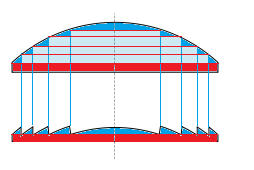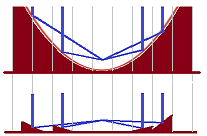Fresnel Lenses
One of the very clever inventions that simplified the process of making large convex lenses was made by French physicist Augustin-Jean Fresnel.
This invention allowed to make and use large lenses at the lighthouses that saved lives of many sailors.
Here is a diagram that explains this invention called Fresnel lens.

Instead of a full convex lens on the top of a picture above Fresnel lens on the bottom cuts off all the parts that do not have any useful functionality (light blue) leaving only the base (red) and prismatic pieces (dark blue) that do the job of refracting the light.
The light blue pieces are only letting the rays of light through, so, by cutting them off, Fresnel was able to construct relatively large lenses of the same functionality as full convex lenses but much lighter and fit to be installed in the lighthouses.
On the picture above, if the parallel rays of light enter the Fresnel lens from below, the lens will focus the rays at a focal point above it, exactly as the full convex lens would do.
Conversely, if the point light source is at Fresnel lens focal point above it, the lens would let the light go down as parallel rays of light.
This type of Fresnel lens is called a positive Fresnel lens, it refracts the light.
Consider now a similar construction with reflected light.
As we know, parabolic mirror reflects the parallel rays of light into its focal point or, conversely, reflects a point light at its focal point into parallel rays of lights.
Similar idea as with Fresnel lenses, can be used to make a reflective mirror acting like a parabolic. It's schematically represented below and called a negative Fresnel lens.

This construction is significantly more compact with practically the same functionality.


No comments:
Post a Comment